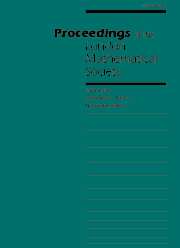Article contents
Sums of connectivity functions on Rn
Published online by Cambridge University Press: 01 March 1998
Abstract
A function f : Rn → R is a connectivity function if the graph of its restriction f|C to any connected C ⊂ Rn is connected in Rn x R. The main goal of this paper is to prove that every function f : Rn → R is a sum of n + 1 connectivity functions (Corollary 2.2). We will also show that if n > 1, then every function g: Rn → R which is a sum of n connectivity functions is continuous on some perfect set (see Theorem 2.5) which implies that the number n + 1 in our theorem is best possible (Corollary 2.6).
To prove the above results, we establish and then apply the following theorems which are of interest on their own.
For every dense Gδ-subset G of Rn there are homeomorphisms h1...,hn of Rn such that Rn=G∪h1(G)∪...∪hn(G) (Proposition 2.4).
For every n >1 and any connectivity function f : Rn → R, if x ∈ Rn and ε >0 then there exists an open set U⊂Rn such that x ∈ U⊂Bn(x,ε), f|bd(U) is continuous, and |(x)-f(y)| < ε for every y∈bd(U) (Proposition 2.7).
- Type
- Research Article
- Information
- Copyright
- London Mathematical Society 1998
- 5
- Cited by


